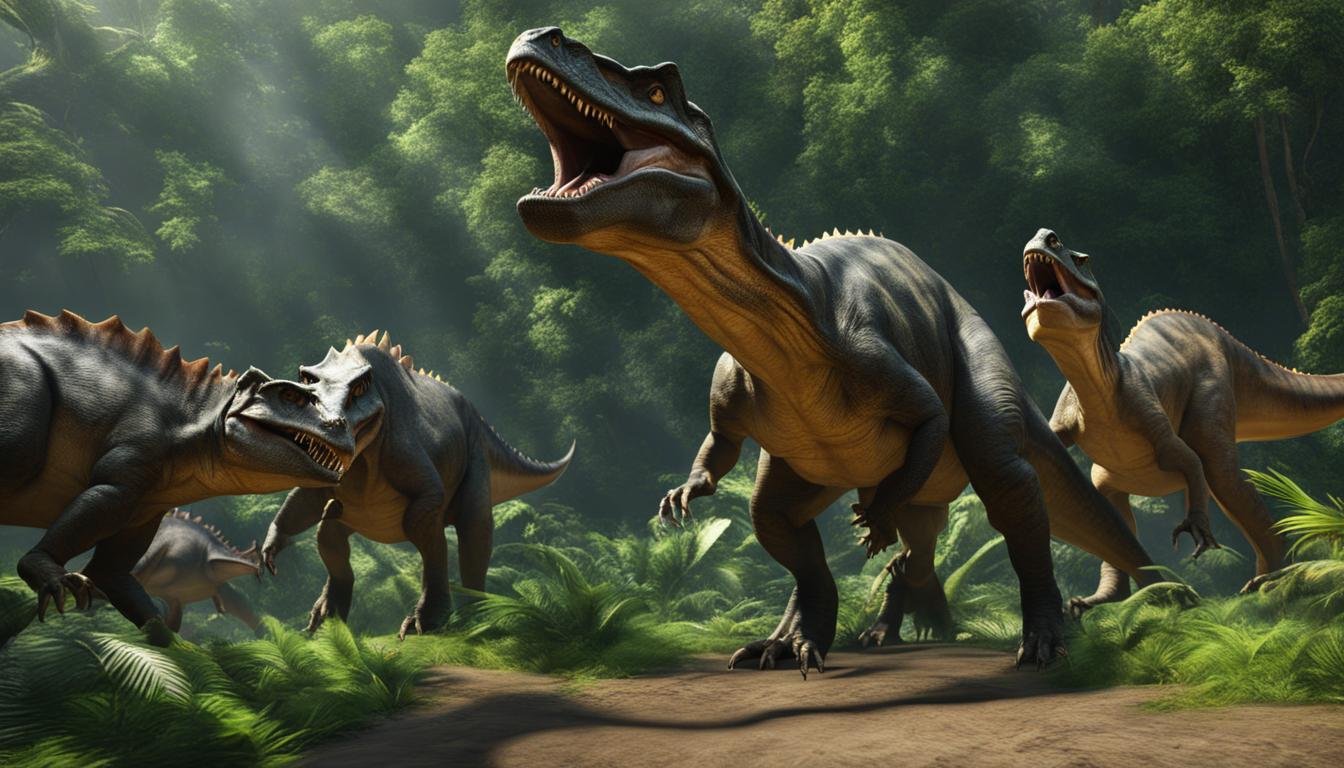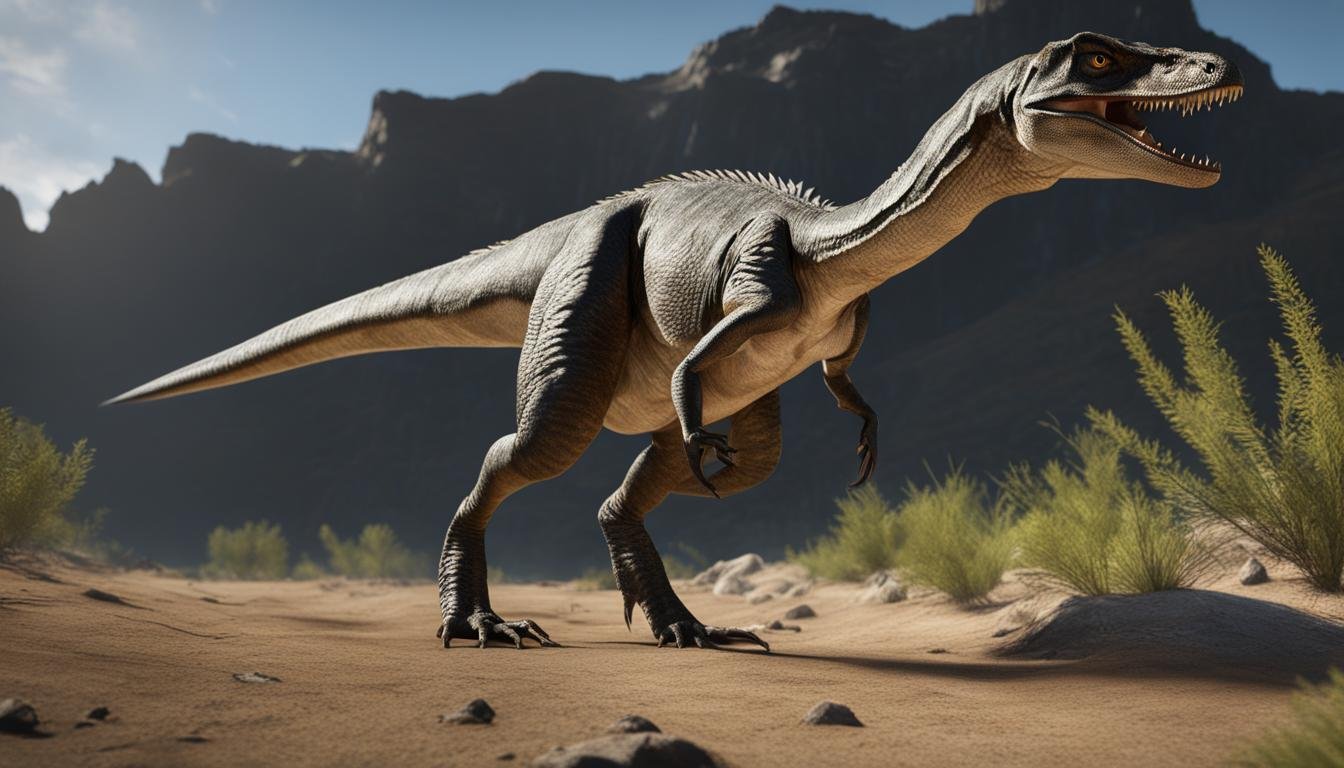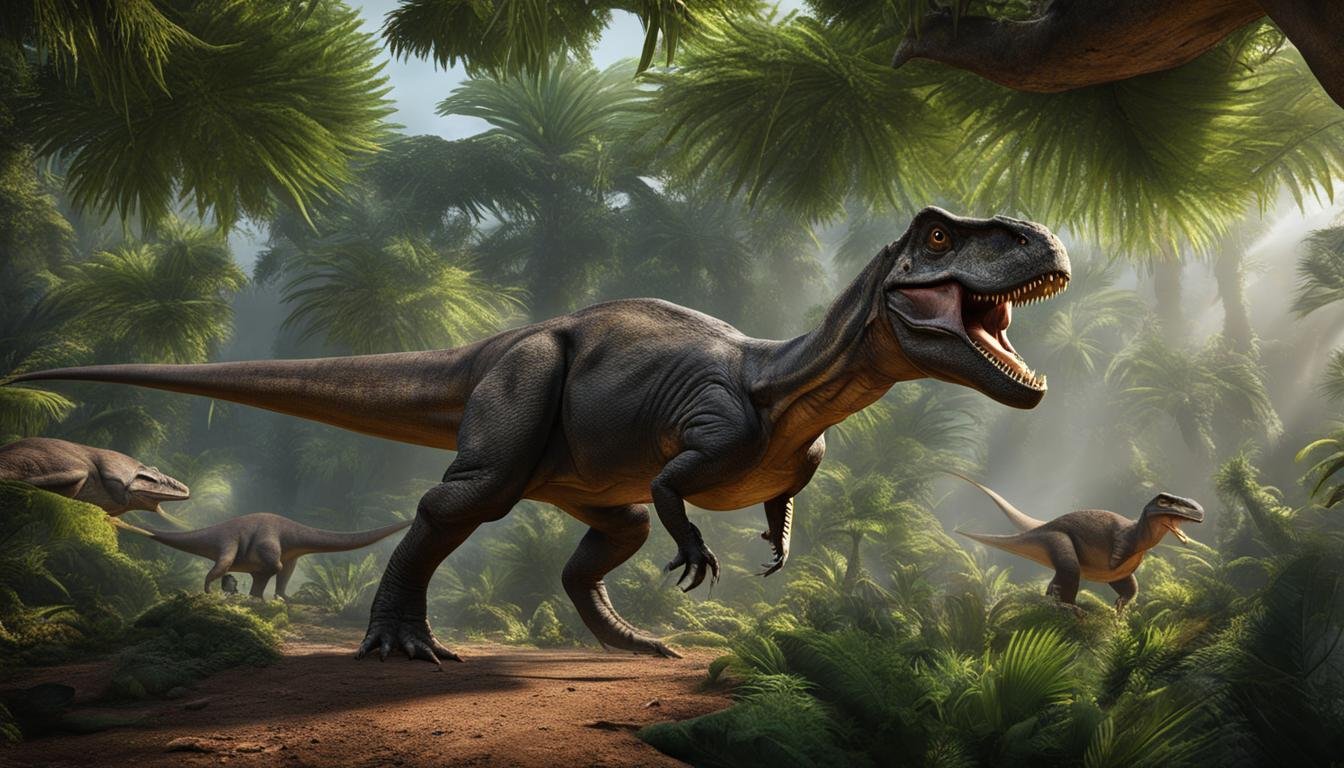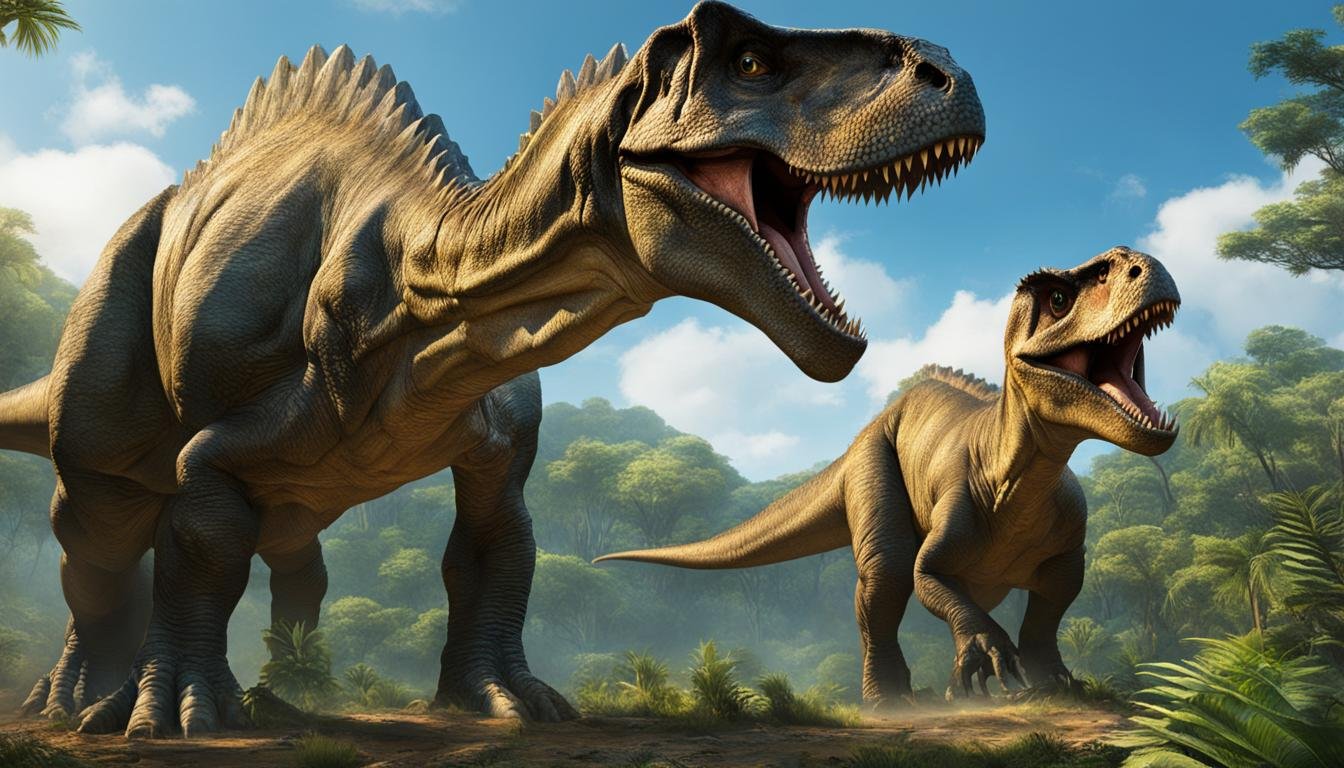Have you ever wondered how dinosaurs sounded? The roaring sounds often portrayed in movies may not be accurate. Recent research suggests that dinosaur vocalizations were quite different from what we imagine. Dr. Julia Clarke discovered that an ancient bird had a vocal organ called a syrinx, similar to modern birds. This finding indicates that dinosaurs might have produced honking sounds instead of roars. While the Jurassic Park films used a combination of animal sounds to create dinosaur vocalizations, the truth may be far more complex.
The Vocal Organs of Dinosaurs
Fossil evidence suggests that dinosaurs may have had vocal organs similar to those found in ancient birds. These vocal organs, known as syrinxes, are responsible for producing sounds in birds. While the syrinx has not been found in non-avian dinosaur fossils, its presence in bird ancestors indicates that dinosaurs may have had the ability to vocalize as well.
The absence of preserved soft tissues in dinosaur fossils makes it challenging to determine the exact structure of their vocal organs. However, studying the skeletal anatomy of dinosaurs and their close relatives, such as birds, provides valuable insights. By comparing the larynx, a vocal organ found in mammals, with the syrinx in birds, scientists can infer the possible presence of similar vocal structures in dinosaurs.
| Dinosaur Vocal Organs | Avian Vocal Organs |
|---|---|
| Larynx (speculation) | Syrinx |
| Based on skeletal anatomy | Structurally identified |
| Similarities with mammals | Unique to birds |
While the exact vocal abilities of dinosaurs remain uncertain, the presence of vocal organs in birds and the similarities between dinosaurs and their avian relatives suggest that dinosaurs had the potential to produce a wide range of vocalizations. Further research and discoveries in the field of paleontology can shed more light on the vocalization abilities and soundscape of these fascinating creatures.
The Evolution of Dinosaur Sounds
In the world of dinosaurs, vocalizations played a crucial role in communication and social interaction. While the popular image of dinosaurs roaring may not reflect their true sounds, recent research suggests that many dinosaurs may have produced closed-mouth vocalizations instead. This evolution in vocalization techniques may have resulted in low-pitched swooshing or growling sounds, similar to those produced by crocodilians.
Scientists have made this connection between dinosaurs and crocodilians due to their shared ancestry and similar vocalization methods. Crocodilians produce low-pitched rumbling sounds by inflating their esophagus or tracheal pouches while keeping their mouths closed. This method of closed-mouth vocalization could explain how certain dinosaurs, like the theropods, made deep and resonating sounds without the need for open-mouth roars.
Further evidence for closed-mouth vocalizations in dinosaurs is found by looking to their modern-day relatives, birds. Birds are the closest living relatives of dinosaurs and use a different vocal organ called a syrinx to produce a wide range of sounds. While the syrinx has not been found in non-avian dinosaur fossils, the presence of a syrinx-like vocal organ in ancient birds suggests that dinosaurs may have had similar vocal abilities.
| Dinosaur Vocalizations | Comparison to Modern Relatives |
|---|---|
| Closed-Mouth Vocalizations | Crocodilians, which share a common ancestor with dinosaurs, make low-pitched rumbling sounds by inflating their esophagus or tracheal pouches while keeping their mouths closed. |
| Open-Mouth Vocalizations | Birds, the closest living relatives of dinosaurs, have a vocal organ called a syrinx that allows for a wide range of sounds, including whistles, guttural bellows, and throaty clicks. |
While the exact nature of dinosaur vocalizations remains a mystery, exploring the evolution of their sounds provides valuable insights into their behavior and communication. By studying the vocal abilities of crocodilians and birds, scientists are piecing together the puzzle of how dinosaurs may have sounded. Continued research in this area promises to shed further light on the fascinating world of dinosaur vocalization.
The Sounds of Jurassic Park
When it comes to the iconic dinosaur sounds in the Jurassic Park films, reality is often blended with creative imagination. The filmmakers used a combination of animal recordings and pitch manipulation to bring the prehistoric creatures to life. Unlike the roaring sounds commonly associated with dinosaurs, the actual sounds were quite different.
One of the key elements in creating the dinosaur vocalizations was the use of animal recordings. Sounds such as elephant bellows, lion and tiger roars, and even the barks of the sound producer’s dog were captured and edited to produce the desired effects. These recordings were then manipulated to match the size and scale of the dinosaurs on screen.
While the dinosaur sounds in Jurassic Park may not be scientifically accurate, they were strategically designed to evoke a sense of awe and wonder. The goal was to transport the audience into a world where these long-extinct creatures roamed the Earth once again. By relying on a combination of animal sounds and careful audio editing, the filmmakers were able to create an immersive experience for moviegoers.

Vocalization Techniques in Jurassic Park
One interesting aspect of the dinosaur sounds in Jurassic Park is the use of pitch manipulation. By altering the pitch of animal recordings, the filmmakers were able to create unique and otherworldly vocalizations. For example, the low-frequency roars commonly associated with large carnivorous dinosaurs were achieved by slowing down and deepening the sounds of animals like tigers and lions.
Another technique used was layering multiple animal sounds to give the dinosaur vocalizations more depth and complexity. This helped to create a sense of realism and make the creatures feel more alive. By combining various animal recordings, the filmmakers were able to create unique and memorable sounds for each type of dinosaur.
| Dinosaur | Animal Sound(s) Used |
|---|---|
| Tyrannosaurus rex | Lion roars + Elephant sounds |
| Velociraptor | Tiger roars + Dolphin clicks |
| Brachiosaurus | Elephant calls + Whale songs |
These creative techniques allowed the filmmakers to bring dinosaurs to life in a way that captivated audiences around the world. While the sounds may not be scientifically accurate, they played a crucial role in the success of the Jurassic Park franchise and continue to thrill viewers to this day.
Debunking the Velociraptor Resonating Chamber
The concept of a “Velociraptor resonating chamber” depicted in the movie Jurassic Park III has been debunked by paleontologists. This idea suggests that a dedicated chamber within the Velociraptor’s skull could modify the timbre and pitch of its vocalizations. However, scientific evidence does not support the existence of such a structure in dinosaurs.
According to paleontologists, a resonating chamber would only amplify the sound produced by the dinosaur, without modifying its timbre or pitch. This common misconception originated from the fictional portrayal in the movie and does not align with our current understanding of dinosaur vocalizations.
To understand how dinosaurs may have communicated, scientists rely on fossil evidence, comparative anatomy, and the vocal abilities of their modern relatives. By studying the structures involved in vocalization, such as the larynx and syrinx, researchers can infer the potential range of dinosaur sounds.
The Challenge of Studying Dinosaur Sounds
Studying dinosaur sounds presents unique challenges due to the nature of the vocalization structures involved. Unlike bones and other hard tissues, the larynx and syrinx responsible for vocalization are soft tissues that do not typically fossilize. As a result, direct evidence of dinosaur vocalizations is scarce, and researchers must rely on indirect methods of inference and reconstruction.
One approach to understanding dinosaur sounds is to study the skeletal anatomy of dinosaurs and compare it to their modern relatives. By examining the structures of living birds and crocodilians, who share a common ancestor with dinosaurs, scientists can make inferences about the vocal abilities of their extinct relatives. For example, the presence of a syrinx in ancient bird fossils suggests that dinosaurs may have also had a similar vocal organ.
Studying dinosaur sounds is like putting together a puzzle with missing pieces. We have to use the available evidence, including the skeletal anatomy of dinosaurs and the vocal abilities of modern relatives, to make educated guesses about how dinosaurs may have sounded.
Another method is the field of paleoacoustics, which studies the sound associated with fossils. By analyzing the acoustic properties of dinosaur vocalizations, researchers can gain insights into their communication systems, behavioral ecology, and social interactions. However, this field is still in its early stages, and much more research is needed to fully understand the mechanics and significance of dinosaur vocalizations.
The Challenge of Studying Dinosaur Sounds
| Challenges | Solutions |
|---|---|
| Fossilized Vocalization | Use indirect methods of inference and reconstruction based on skeletal anatomy and modern relatives |
| Soft Tissues | Study the vocal organs of living birds and crocodilians to make educated guesses about dinosaur vocal abilities |
| Reconstruction | Utilize paleoacoustics to analyze the acoustic properties of fossils and gain insights into dinosaur communication systems |
| Modern Relatives | Compare the vocal abilities of birds and crocodilians to make inferences about dinosaur vocalizations |
| Inference | Combine multiple lines of evidence to form a comprehensive understanding of dinosaur sounds |
Overall, studying dinosaur sounds requires a multidisciplinary approach, combining paleontological research, comparative anatomy, and bioacoustic analysis. While challenges persist, ongoing advancements in technology and new fossil discoveries continue to expand our understanding of these enigmatic ancient creatures and their vocalizations.
The Potential Range of Dinosaur Vocalizations
Based on the size and anatomy of dinosaurs, scientists speculate that their vocalizations would have had low frequencies and high amplitudes. Closed-mouth vocalizations, similar to those produced by crocodilians, could have created percussive, low-pitched sounds. In some cases, these sounds may have even reached the infrasound range, which is below the range of human hearing. The large size of dinosaurs would have allowed these sounds to propagate over long distances.
Infrasound is characterized by frequencies below 20 Hz, and it is known for its ability to travel long distances and penetrate through obstacles. Dinosaurs may have utilized infrasound as a means of communication, especially for long-range vocalizations. This low-frequency sound could have been used for various purposes such as territorial defense, mating calls, or even warning signals within a herd.
Additionally, the closed-mouth vocalizations of dinosaurs may have produced high amplitudes, making them more impactful and attention-grabbing. The combination of low frequencies and high amplitudes would have created a powerful and intimidating acoustic presence for these ancient creatures.
Vocal Communication in Dinosaurs
The potential range of dinosaur vocalizations raises interesting questions about their vocal communication. By producing percussive, low-pitched sounds with high amplitudes, dinosaurs could have communicated effectively over long distances, potentially conveying important information to their conspecifics. Scientists hypothesize that these sounds could have played significant roles in various aspects of dinosaur behavior, including establishing dominance, attracting mates, and signaling danger.
“The potential range of dinosaur vocalizations, with their low frequencies and high amplitudes, suggests a dynamic soundscape filled with powerful calls, reverberating through ancient landscapes.”
| Dinosaur Vocalization Characteristics | Description |
|---|---|
| Low Frequencies | Due to their large size and closed-mouth vocalizations, dinosaurs may have produced sounds in the low-frequency range, potentially reaching infrasound levels. |
| High Amplitudes | The closed-mouth vocalizations of dinosaurs could have generated sounds with high amplitudes, creating a powerful acoustic presence. |
| Percussive Sounds | By inflating their esophagus or tracheal pouches while keeping their mouths closed, dinosaurs may have produced percussive, low-pitched sounds with a distinct impact. |
While our knowledge of dinosaur vocalizations is still limited, exploring the potential range of their vocal abilities provides valuable insights into the acoustic world of these extraordinary creatures. Further research in paleoacoustics, combined with new discoveries and analyses of dinosaur fossils, will continue to shed light on the fascinating soundscape of the prehistoric times.

The Influence of Birds on Dinosaur Sounds
The evolution of vocal abilities in birds provides valuable insights into the potential vocalizations of their extinct relatives, the dinosaurs. Although concrete evidence of syrinxes in dinosaurs is lacking, studying avian vocalizations can help us understand the range of sounds that dinosaurs may have been capable of producing.
Birds, as the direct descendants of dinosaurs, have evolved a unique vocal organ called the syrinx. This complex structure allows birds to produce a wide range of sounds, including whistles, guttural bellows, and throaty clicks. If dinosaurs had similar vocal structures, they may have had a diverse vocal repertoire.
“The vocalizations of living birds provide us with a glimpse into the potential vocal abilities of their extinct relatives, the dinosaurs. By studying the syrinx evolution in birds, we can make informed speculations about the sounds that dinosaurs may have produced.”
While the presence of syrinxes in dinosaurs remains uncertain, the vocal abilities of modern birds can still inform our understanding of dinosaur vocalizations. By examining the vocalizations of their closest living relatives, we can gain insights into the acoustic signals that dinosaurs may have used for communication, courtship, and territorial displays.
| Avian Vocalizations | Description |
|---|---|
| Whistles | High-pitched, melodic sounds used for communication and attracting mates. |
| Guttural Bellows | Low-pitched, resonant vocalizations used for territorial displays and intimidation. |
| Throaty Clicks | Short, percussive sounds produced by rapid muscle contractions, often used in courtship rituals. |

While there are still many unanswered questions about dinosaur vocalizations, exploring the vocal abilities of living birds offers valuable insights. By studying the syrinx evolution, vocal repertoire, and acoustic signals of birds, scientists can continue to refine their understanding of how dinosaurs may have sounded. The influence of birds on our understanding of dinosaur vocalizations is an exciting area of research that holds the potential to uncover more about these ancient creatures and their vibrant soundscape.
The Mystery of Dinosaur Vocalizations
The vocal repertoire of dinosaurs continues to elude scientists, leaving many intriguing questions unanswered. Researchers are eager to unlock the secrets of dinosaur vocalizations and gain a better understanding of their vocal behaviors and social interactions. With the field of paleoacoustics, the study of sound associated with fossils, scientists are making strides in deciphering the acoustic world of these ancient creatures.
One of the primary challenges in studying dinosaur vocalizations lies in the fact that soft tissues involved in vocal production do not typically fossilize. This means that direct evidence of their vocal abilities is scarce. However, by examining the skeletal remains of dinosaurs and studying the vocalizations of their modern relatives, such as birds and crocodilians, researchers can make informed inferences about dinosaur sounds.
“The vocal repertoire of dinosaurs continues to elude scientists, leaving many intriguing questions unanswered.”
Paleoacoustic research has provided valuable insights into the potential range of dinosaur vocalizations. Scientists speculate that dinosaurs, with their large size and unique anatomy, may have produced closed-mouth vocalizations, creating percussive, low-pitched sounds similar to those made by crocodilians. Additionally, the large size of dinosaurs suggests that their vocalizations may have reached the infrasound range, which is below the range of human hearing and can travel over long distances.
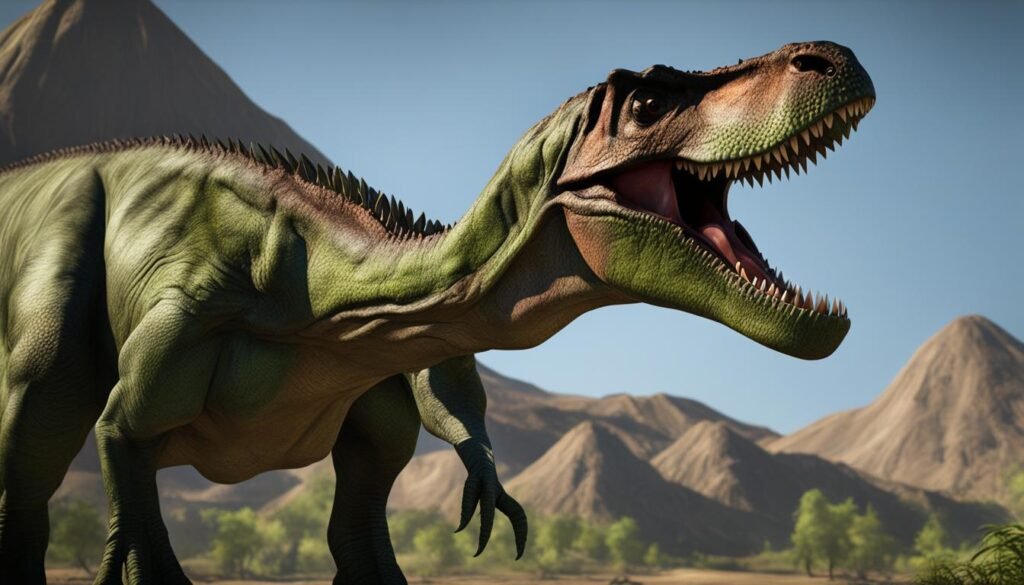
Dinosaur Vocal Repertoire
| Dinosaur Vocalizations | Dinosaur Behavior | Social Interaction |
|---|---|---|
| Low-pitched growls | Aggression, territoriality | Establishing dominance, communication within groups |
| Deep resonant bellows | Attracting mates, courtship rituals | Signaling reproductive fitness, communication between sexes |
| Guttural clicks and whistles | Alarm calls, coordination during hunts | Warning others, maintaining group cohesion |
Despite these advancements, many aspects of dinosaur vocalizations remain shrouded in mystery. The true extent of their vocal repertoire, as well as the nuances of their communication systems and the role of vocalizations in their behavioral ecology, are still largely unknown. Further research and discoveries in paleoacoustics will shed light on the fascinating world of dinosaur sounds and offer valuable insights into the lives of these ancient creatures.
The Importance of Understanding Dinosaur Sounds
Understanding dinosaur sounds is a crucial aspect of paleontological research that allows us to gain a comprehensive understanding of these ancient creatures. By studying their vocalizations, we can uncover important information about their communication systems, predator-prey interactions, and overall species behavior. The analysis of audio recordings and bioacoustic data provides valuable insights into the acoustic signals used by dinosaurs, shedding light on their social dynamics and ecological roles within ancient ecosystems.
Paleontological research has shown that audio recordings and bioacoustic analyses can enhance our knowledge of dinosaur sounds and provide captivating glimpses into the prehistoric world. By comparing the vocalizations of extant animals, such as birds and crocodilians, researchers can make educated inferences about the vocal abilities and behaviors of dinosaurs. These studies help us reconstruct the soundscapes of long-extinct environments, painting a more vivid picture of the habitats in which dinosaurs lived.
The study of dinosaur sounds also contributes to our understanding of predation and species interactions in ancient ecosystems. By examining the acoustic signals used by both predators and prey, scientists can explore the intricate dynamics of predator detection, territory defense, courtship rituals, and mate selection. These vocalizations played a vital role in the survival and reproductive success of dinosaurs, allowing them to communicate, compete, and form complex social structures within their respective species.
Comparison of Dinosaur Vocalizations and Modern Animal Sounds
| Dinosaur Vocalizations | Modern Animal Sounds | |
|---|---|---|
| Communication Systems | Dinosaur vocalizations likely involved various sounds and calls to convey messages, establish dominance, and attract mates. | Modern animals use vocalization for communication purposes, displaying a wide range of sounds, calls, and songs to convey messages within their species. |
| Predation | Dinosaur vocalizations may have been used as warning signals or to coordinate group hunting strategies. | Modern predators use vocalizations to communicate with other members of their pack or to intimidate and warn potential prey. |
| Species Interactions | Vocalizations played a significant role in mate selection, territorial disputes, and social hierarchies within dinosaur species. | Modern animals use vocalizations for similar purposes, such as mate selection, territorial defense, and maintaining social structures. |
By exploring the importance of understanding dinosaur sounds, scientists can gain a deeper appreciation for the complexity of the prehistoric world and the richness of its acoustic landscape. Continued research in this field will unlock further insights into the vocal abilities, behaviors, and social interactions of dinosaurs, allowing us to better understand and appreciate these majestic creatures that once roamed the Earth.
Conclusion
In conclusion, the study of dinosaur vocalization is a fascinating field that continues to captivate researchers across the globe. While we may never know with certainty exactly how dinosaurs sounded, we can draw valuable insights from fossil evidence, modern relatives, and innovative techniques. The research suggests that dinosaur vocalizations were likely different from the roaring sounds often portrayed in movies.
Recent discoveries indicate that ancient birds had a vocal organ called a syrinx, similar to modern birds. This suggests that dinosaurs may have made honking sounds instead of roars. However, the absence of the syrinx in non-avian dinosaur fossils means that we can only speculate on the vocal abilities of non-avian dinosaurs based on the structures of their close relatives, like birds.
While there are still many unanswered questions about the nature and significance of dinosaur vocalizations, studying their mechanics is crucial for gaining a comprehensive understanding of these ancient creatures. By unraveling the mysteries of dinosaur vocalization, we can shed light on their communication systems, behavior, and interactions with other species. Continued research in this area will undoubtedly contribute to our knowledge of these intriguing ancient creatures.

